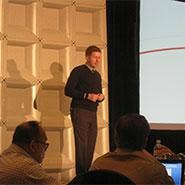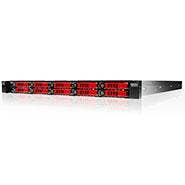SolidFire: Intros Element X, Guarantees Flash Array Upgrades, Endurance

SolidFire, in a move to distance itself from its fellow startup all-flash storage array vendors, this week went beyond its unveiling of a new all-flash array to introduce new software capabilities and guarantees its solutions would not suffer from future compatibilities or flash memory wear.
The company also unveiled a software-only version of its all-flash array technology aimed at making it possible for hyper-scale data center operators and large-scale service providers or OEMs to use commodity servers to build their own flash arrays.
Dave Wright, CEO of SolidFire, said at the company's analyst day, held Wednesday in Boulder, Colo., that SolidFire wants to be a force for disruption in the storage industry.
[Related: CommVault Channel Veteran Joins All-Flash Array Maker SolidFire]
"Storage is very often the boat anchor when people are transforming their data centers," Wright told the audience, which comprised mainly storage industry analysts. "We don't think it should be. Storage should be pulling the transformation."
On the hardware side, SolidFire introduced the SF9605, a new all-flash array node that comes configured with 9.6 TBs of raw capacity utilizing SanDisk cMLC-based SSDs. With compression and deduplication, the SF9605 can store up to about 34.5 TBs, said Adam Carter, vice president of product management for SolidFire.
It features a 25 percent lower cost-per-GB than SolidFire's flagship SF9010, with slightly lower performance, Carter said at the conference. "With the SF9010, there are some cases where it is too fast," he said.
More important than the new hardware, however, was the introduction of the SolidFire FlashForward program, a move that demonstrates SolidFire's commitment to the longevity of its all-flash arrays, Carter said.
The SolidFire FlashForward program has two main planks.
The first is the Platform Compatibility Guarantee, which ensures that customers who purchase a SolidFire solution know those systems will be compatible with all future software upgrades.
This means customers always know their investment is protected, Carter said. "If you happen to get the last shipment of a particular node because of upgrades, you're still guaranteed that for the entire supported life of that platform, you'll be compatible with the latest features and compatibilities."
Carter later qualified his statement by noting that the guarantee is for as long as a platform is supported by SolidFire, which is typically five years after it is no longer available for sale.
NEXT: Software-Defined All-flash Storage Array: SolidFire Element X

The second plank is the Unlimited Drive Wear Guarantee under which SolidFire guarantees the flash memory in the array will not wear out over time due to multiple writes of data. Carter said this guarantee will hold, regardless of customers' workloads or use cases, to eliminate concerns about flash endurance.
Carter also provided an advance look at the next version of SolidFire's flash storage operating system, Element OS 8 "Oxygen."
Element OS 8, slated to ship in the second quarter, will add synchronous replication, and will be compatible for multitenant data center infrastructures with thousands of users, he said.
Also new is incremental compression, a way of recompressing already compressed data to save an additional 30 percent space without impacting read-and-write performance, Carter said.
Element OS 8 also includes snapshot scheduling and a new data-retention policy engine, he said.
SolidFire also used the event to introduce the all-flash storage industry's first software for turning industry-standard servers into all-flash storage arrays.
Wright said the new technology, SolidFire Element X, is aimed at hyper-scale data centers, service providers and OEMs who have scale to benefit from building their own all-flash storage arrays based on SolidFire's technology.
The software, based on SolidFire's Element operating system, is delivered as software to potential customers who deal with tens of petabytes of capacity per year and for whom IT is a profit center. The software has already been officially validated by SolidFire for use with Dell R630 and Cisco UCS servers, and the company expects to qualify additional platforms as well, Wright said.
"It's important," he said. "We are bringing the servers into our labs to qualify. ... If it doesn't pass our muster, we won't validate it."
Element X, which unlike virtual storage appliances runs on bare-metal servers, could potentially someday be available to Dell and Cisco solution providers, Wright said in response to a question from CRN. "But that's not the goal of Element X," he said.
Instead, Element X really needs scale to work properly, Wright said. At smaller scale, customers are unlikely to be able to purchase the server hardware at a lower cost than SolidFire does, and the integration, support, training, imaging, burning and inventory control needed to support all-flash arrays make it easier for mainstream customers and channel partners to work with SolidFire-branded solutions, he said.
NEXT: SolidFire From The Channel View
One channel partner, however, is determined to take advantage of SolidFire Element X.
Jeff Dickey, chief innovation officer at Redapt, a Redmond, Wash.-based SolidFire channel partner that specializes in turnkey private cloud solutions and helps build IT infrastructures for services providers, told CRN there is room for solution providers to work with the Element X software, although a certain scale will be necessary.
The main resistance to adopting SolidFire Element X is the fact that preconfigured all-flash storage arrays are the main choice for mainstream customers, Dickey said.
"Customers like the appliance approach," he said. "It's solid. But a lot of customers will ask about Element X."
More broadly, Element X shows that SolidFire has graduated from the rank of startup, Dickey said. "It shows how mature and agile SolidFire is," he said.
That maturity is shown in the other SolidFire news, Dickey said.
For instance, to offer an endurance guarantee for the flash technology in the arrays is "kind of crazy," he said.
"The folks to get SolidFire will want to use their arrays for six years," he said. "But enterprises need the assurance that the flash will continue to work as promised. This is a generous offering from SolidFire. It shows SolidFire is mature, and is not a startup anymore."
SolidFire also has a winner with its Platform Compatibility Guarantee, Dickey said. "Customers will know there's no more need for forklift upgrades," he said. "New systems down the road will feature five or 10 times the capacity of systems sold now. And SolidFire promises nondisruptive upgrades and commissioning of new systems."
PUBLISHED FEB. 26, 2015